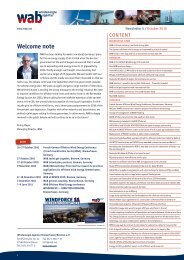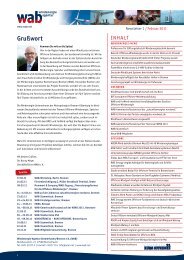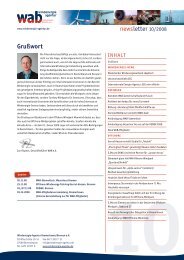Wind Energy
Wind Energy
Wind Energy
You also want an ePaper? Increase the reach of your titles
YUMPU automatically turns print PDFs into web optimized ePapers that Google loves.
OffshOre #2 | The Magazine<br />
MeerwInd – a fInancIal InvestOr wIth the wInd In hIs saIls<br />
“This location has charm”<br />
Offshore magazine: What motivates<br />
a financial investor like<br />
blackstone to invest in offshore<br />
wind power?<br />
Jens assheuer: in the first<br />
instance the private equity industry<br />
is interested in the size of<br />
the investment. We have a project<br />
volume of more than one billion<br />
euros here, with an equity capital<br />
requirement of several hundred<br />
million euros. These are the usual<br />
orders of magnitude for private<br />
equity firms like Blackstone.<br />
What made you choose, of all<br />
things, one of the most ambitious<br />
projects? 400 MW, 80 km<br />
from the shore – couldn’t you<br />
have found an easier project?<br />
apart from the nordergründe<br />
wind farm by energiekontor,<br />
there are hardly any small and<br />
nearshore projects in germany.<br />
nor are these smaller projects<br />
looking for equity. apart from<br />
that, the equity capital requirements<br />
for such projects are<br />
30<br />
Just in from northwestern Germany, JEnS ASShEUER arrives at Berlin’s central railway<br />
station in a relaxed mood. A meeting has been cancelled in Berlin, which means we can<br />
look for somewhere quiet in the nearby Mitte district to have the interview. Over cups of<br />
tea and mini satay skewers, the managing director of <strong>Wind</strong>MW in Bremerhaven explains<br />
the offshore plans of his majority shareholder Blackstone from New York.<br />
too small for an investor like<br />
Blackstone. So the question<br />
never arose.<br />
What are the plus points of<br />
Meerwind?<br />
Water depths of 22 to 26 metres<br />
are very moderate in comparison<br />
with 40 or 45 metres in other<br />
projects – this is reflected in<br />
the design and the costs of the<br />
foundation structures. We are<br />
only 12 nautical miles away from<br />
heligoland, which means we can<br />
carry out servicing and repairs<br />
from the island. Our reaction<br />
times are less than an hour. We<br />
would have to allow five to six<br />
hours by boat from the mainland.<br />
This location has charm.<br />
how many installers and<br />
technicians will you station on<br />
heligoland?<br />
We want to operate the wind farm<br />
ourselves from the outset and<br />
also carry out maintenance and<br />
repair work ourselves. We won’t<br />
know the exact number of techni-<br />
cians until our maintenance and<br />
service plan is finalised.<br />
You compared a large number of<br />
projects before the purchase in<br />
July 2008. how do they differ<br />
from each other?<br />
Because the feed-in tariff under<br />
the german Renewable energy<br />
Sources act (eeg) varies according<br />
to the distance from the<br />
shore and water depth, there is<br />
no longer any easy distinction<br />
between good and bad projects.<br />
The eeg does a good job of<br />
evening that out. The status of<br />
project development was more<br />
important to us. if you buy a<br />
project today, the earliest you<br />
can build in 2012. The investors<br />
have to come up with significant<br />
supplier contracts and financial<br />
resources before transpower,<br />
formerly e.On netz, will lay the<br />
grid connection in the north Sea.<br />
This work has a lead time of up<br />
to 36 months. The timeline is the<br />
most critical point.<br />
MeerwInd Ost/sÜd OffshOre wInd farMs<br />
The Meerwind Ost/Süd offshore wind farms (Meerwind) are situated 12 nautical miles (23 kilometres)<br />
to the north of heligoland and 50 miles (80 kilometres) from the north German coast. <strong>Wind</strong>MW, based<br />
in Bremerhaven, is responsible for the planning. Blackstone has an 80 percent stake in the company<br />
and <strong>Wind</strong>land Energiezeugung owns 20 percent. The project was granted approval by the German<br />
Federal Maritime and hydrographic Agency (BSh) in hamburg on 16 May 2007. The nordsee Ost (Essent/RWE<br />
Innogy and Amrumbank West (E.On) wind farms are situated directly next in the north to<br />
Meerwind. Their shared power transmission line will be routed via the Brunsbüttel connection point.<br />
The Meerwind project is formally divided into two wind farms. In each case 40 turbines with 3.6 or<br />
5 MW are to be constructed in Meerwind Ost and Meerwind Süd. The project is being funded via a<br />
project financing model. <strong>Wind</strong>MW engaged KfW-IPEX and dexia to prepare the project financing.<br />
What is the range of annual full<br />
load hours that can be attained<br />
and what is your estimate for<br />
Meerwind?<br />
The equivalent full load hours are<br />
in the region of 3,800.<br />
since blackstone’s involvement<br />
was announced in summer<br />
2008, nothing more has been<br />
heard about the project. What<br />
stage is the technical planning<br />
currently at?<br />
There have already been talks<br />
and negotiations with the main<br />
suppliers, and the plans for<br />
maintenance and operation have<br />
progressed well. We have also<br />
begun preparing everything to<br />
satisfy e.On’s grid connection<br />
conditions and hence secure a<br />
promise of a grid connection.<br />
Which wind turbines will be<br />
used? Originally 3.6-MW turbines<br />
were planned.<br />
We are investigating both a 288<br />
MW and a 400 MW option.<br />
do you see any big differences<br />
between manufacturers?<br />
The turbine manufacturers have<br />
not yet come as far as they should<br />
have done. They have not ramped<br />
up capacities sufficiently yet and<br />
their sub-suppliers also have not<br />
made sufficient investments. Besides<br />
that, the turbines’ test run<br />
times are too short. One to three<br />
years of operational experience<br />
is not much for a technology that<br />
is supposed to withstand more<br />
than 20 years of extreme weather<br />
conditions.








